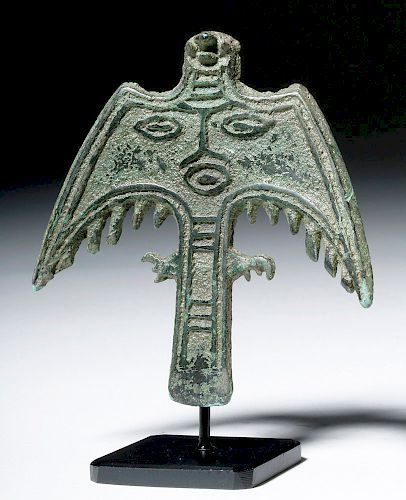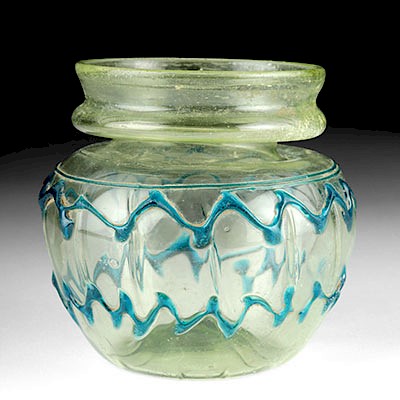8th C. Russian Bronze Pendant, Bird-Shaped
Lot 41
About Seller
Artemis Fine Arts
686 S Taylor Ave, Ste 106
Louisville, CO 80027
United States
Selling antiquities, ancient and ethnographic art online since 1993, Artemis Gallery specializes in Classical Antiquities (Egyptian, Greek, Roman, Near Eastern), Asian, Pre-Columbian, African / Tribal / Oceanographic art. Our extensive inventory includes pottery, stone, metal, wood, glass and textil...Read more
Estimate:
$3,800 - $5,700
Absentee vs Live bid
Two ways to bid:
- Leave a max absentee bid and the platform will bid on your behalf up to your maximum bid during the live auction.
- Bid live during the auction and your bids will be submitted real-time to the auctioneer.
Bid Increments
| Price | Bid Increment |
|---|---|
| $0 | $25 |
| $300 | $50 |
| $1,000 | $100 |
| $2,000 | $250 |
| $5,000 | $500 |
| $10,000 | $1,000 |
| $20,000 | $2,500 |
| $50,000 | $5,000 |
| $100,000 | $10,000 |
| $200,000 | $20,000 |
About Auction
By Artemis Fine Arts
Aug 16, 2018
Set Reminder
2018-08-16 10:00:00
2018-08-16 10:00:00
America/New_York
Bidsquare
Bidsquare : Clearance Sale - Ancient / Ethnographic Art
https://www.bidsquare.com/auctions/artemis-gallery/clearance-sale---ancient-ethnographic-art-3368
These lots are going, going, gone... plus a nice selection of lots brand-new to auction! Artemis Fine Arts info@artemisfinearts.com
These lots are going, going, gone... plus a nice selection of lots brand-new to auction! Artemis Fine Arts info@artemisfinearts.com
- Lot Description
**Originally Listed At $4000**
Russia, Western Siberia, Yamal Peninsula and Khanty-Mansi Autonomous Okrug (District), 8th to 10th century CE. A solid, cast bronze ornitomorphic (bird-shaped) pendant in the form of a frontally facing bird presenting its outspread wings, bifurcated tail, a mask on its breast, and an expressive face of its own with its bulging eyes and short, curved beak. Note the intricately chased linear and geometric motifs adorning the wings, breast, and tail of this piece, which look like more eyes, rivaling the artistry of Viking Age bronze casting. Details like feather tips and claws give further detail to the bird. An applied loop is attached to the back for suspension. A similar example was discovered by archaeologists from the Scientific Research Center of the Arctic in Salekhard. (See http://www.dailymail.co.uk/sciencetech/article-2402734/The-jewellery-proves-Siberians-worshipped-brown-bear.html) Among them, archaeologist Andrey Gusev stated that bronze items from Northern Siberia during this period are incredibly sparse and most importantly, each piece is a significant addition to this relatively new field of study and brings us closer to understanding the rituals of the ancient inhabitants residing there. A remarkable example from the Golden Age of bronze casting in the north of Western Siberia. Custom stand. Size: 3" W x 3.25" H (7.6 cm x 8.3 cm)
In western Siberia during the Bronze Age, which there extended into what we in the west think of as the medieval period, there were sanctuaries in the forest where archaeologists and local people have found evidence of bronze and silver smelting, as well as bronze and silver artifacts. These sanctuaries seem to have accumulated, over many generations, metal gifts left to the spirits who patronized them. These sanctuaries played a role in local life into the early 20th century, with many people being afraid of disturbing the ancient metal items within; accounts of archaeological expeditions into the 1980s include much information on what superstitious activities the scientists had to go through before local informants would take them to sites. These objects are rare outside of the Russian world, and nearly all of the information published about them is in Russian. They often include stylized human figures and animal iconography. For humans, there is heavy emphasis in depiction placed on certain parts of the body, like eyes and hands; animals seem to be more naturalistically drawn (although not entirely). The relationship between this kind of artistic expression and that of the Perm Animal Style (also Permian Animal Style) is not currently known, but they were contemporaneous and geographically close, and have many of the same elements. These people may also have been inspired by the Scytho-Siberians who came before them, and the Vikings who they could have had contact with in the west.
For further understanding of similar bronze artifacts featuring images of birds see the catalogue for the historic exhibition entitled, "The animalistic Style of Western Siberia" at the Fine Arts Museum of Surgut (2000).
Provenance: Ex-LA County Collection formed bewteen 1980 and 2000
All items legal to buy/sell under U.S. Statute covering cultural patrimony Code 2600, CHAPTER 14, and are guaranteed to be as described or your money back.
A Certificate of Authenticity will accompany all winning bids.
We ship worldwide and handle all shipping in-house for your convenience.
#117339Very good condition and clear design, with expected signs of use, and the tail having some of the design worn away.Condition
- Shipping Info
-
All shipping is handled in-house for your convenience. Your invoice from Artemis Gallery will include shipping calculation instructions. If in doubt, please inquire BEFORE bidding for estimated shipping costs for individual items.
-
- Buyer's Premium



 EUR
EUR CAD
CAD AUD
AUD GBP
GBP MXN
MXN HKD
HKD CNY
CNY MYR
MYR SEK
SEK SGD
SGD CHF
CHF THB
THB
















